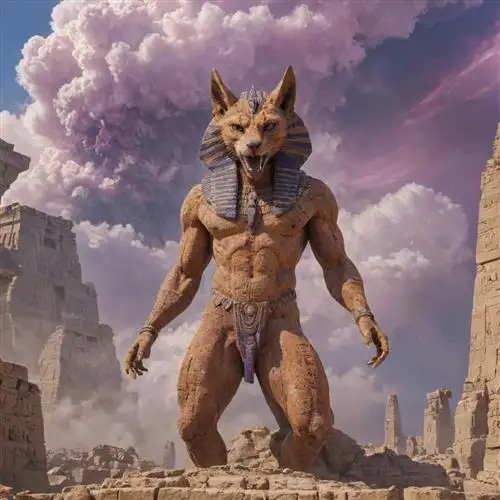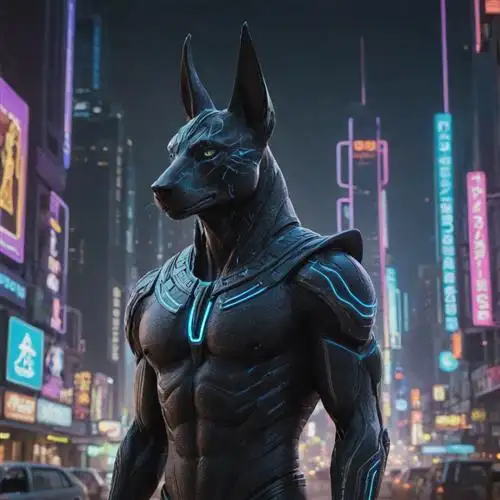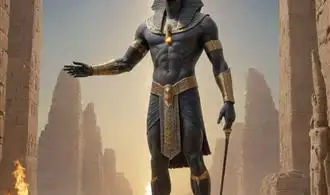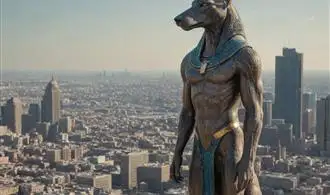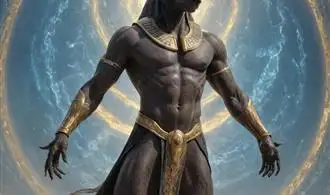
The Mythical Origins of Anubis
Anubis, the Egyptian god associated with mummification and the afterlife, has been the subject of much fascination and speculation throughout the centuries. Tracing the origins of this enigmatic deity can provide valuable insights into the rich tapestry of ancient Egyptian mythology and beliefs.
One of the widely accepted theories suggests that Anubis emerged as a composite deity, combining elements from various earlier canine or jackal-headed deities worshipped in different regions of ancient Egypt. These early canine gods, such as Wepwawet and Anpu, were believed to be associated with the afterlife, funerary rites, and the protection of the dead.
The name "Anubis" itself is derived from the Greek form of the Egyptian name "Anpu" or "Inpu," which may have its roots in the ancient Egyptian word for "royal child" or "privileged one." This connection to royalty and privilege further reinforces the significance of Anubis within the Egyptian pantheon.
Anubis is often depicted as a jackal-headed man or a jackal, and this distinctive iconography is believed to have symbolic meaning. The jackal was a common sight in the ancient Egyptian deserts, where it would scavenge and prowl among the tombs and burial sites. This association with the dead and the liminal spaces between the living and the afterlife contributed to Anubis's role as the guardian and protector of the deceased.
Furthermore, the jackal's keen sense of smell and ability to navigate the treacherous desert terrain were likely seen as desirable qualities for a deity tasked with guiding the souls of the dead through the underworld. Anubis's role as the embalmer and protector of the mummification process also likely stemmed from these canine-like characteristics.
Interestingly, the worship of Anubis predates the unification of ancient Egypt, with evidence of his cult centers existing in various regions even before the emergence of the Pharaonic dynasties. This suggests that Anubis was a long-standing and deeply ingrained figure within the religious and cultural fabric of ancient Egyptian society.
As the pantheon of Egyptian deities evolved and the influence of different regional cults waxed and waned, Anubis's role and attributes also underwent transformations. He became closely associated with other important funerary deities, such as Osiris, and played a crucial role in the complex rituals and beliefs surrounding the afterlife.
The Roles and Responsibilities of Anubis
Anubis, the Egyptian god associated with death and the afterlife, played a crucial role in the religious beliefs and practices of ancient Egypt. As the protector of the dead, Anubis was responsible for overseeing the complex process of mummification and guiding the souls of the deceased into the next life.
One of Anubis's primary responsibilities was the mummification process. The ancient Egyptians believed that the preservation of the physical body was essential for the soul's successful transition to the afterlife. Anubis, with his jackal-like head and black fur, was believed to have the knowledge and skill to properly prepare the deceased for their journey into the next world. He would oversee the removal of the internal organs, the drying of the body, and the wrapping of the mummy in linen.
In addition to his role in mummification, Anubis was also responsible for guiding the souls of the dead through the perilous journey to the afterlife. This journey was fraught with dangers, and Anubis was believed to be the protector and guide who would ensure the safe passage of the deceased to the underworld. He would accompany the dead to the Hall of Judgment, where the heart of the deceased would be weighed against the feather of truth. If the heart was found to be pure, the soul would be allowed to enter the afterlife and join the company of the gods.
Anubis also played a role in the worship and veneration of the dead. The ancient Egyptians believed that the dead could communicate with the living, and Anubis was seen as the mediator between the two realms. Offerings and prayers to Anubis were believed to help the deceased find peace and prosperity in the afterlife.
The Symbolic Significance of Anubis Iconography
Anubis, the ancient Egyptian god of the dead, is renowned for his distinctive iconography - the black jackal-headed figure that has captivated the imaginations of people across cultures and centuries. This symbolic representation of Anubis holds profound significance, reflecting the multifaceted nature of his divine role and the deeper insights into ancient Egyptian beliefs and practices.
The choice of the jackal-headed form is not arbitrary, but rather a deliberate and symbolic choice by the Egyptians. Jackals were observed to linger near gravesites and tombs, scavenging the remains of the deceased. This behavior led the Egyptians to associate these canine creatures with the realm of the dead and the process of transition from life to the afterlife. By depicting Anubis with the head of a jackal, the Egyptians were emphasizing his role as the guardian and protector of the dead, facilitating the journey of the deceased into the afterlife.
The black coloration of Anubis' figure also holds significant symbolic meaning. In ancient Egyptian mythology, the color black was associated with the fertile soil of the Nile River valley, which was crucial for the sustenance of life. Additionally, the color black was symbolic of the color of mummified flesh, representing the process of death and rebirth. By portraying Anubis in black, the Egyptians were connecting him to the cycle of life, death, and regeneration - a fundamental aspect of their beliefs about the afterlife.
The iconography of Anubis also includes specific postures and gestures that convey his divine role. In some depictions, Anubis is shown standing upright, holding a was scepter, a symbol of power and authority. In other representations, he is shown kneeling or crouching, performing the crucial ritual of embalming the deceased, guiding and protecting the soul's journey to the afterlife. These postures and actions emphasize Anubis' role as the overseer and facilitator of the funerary rites, ensuring the proper transition of the deceased into the realm of the dead.
Anubis in the Ancient Egyptian Afterlife
Anubis, the enigmatic jackal-headed deity, held a pivotal role in the ancient Egyptian afterlife. As the god of embalming and the protector of the dead, Anubis guided the deceased through the intricate and often perilous journey to the afterlife. His presence was essential, as he oversaw the mummification process, ensuring the preservation of the physical body, a crucial aspect of ancient Egyptian belief in the afterlife.
In the ritual of the "Opening of the Mouth," Anubis played a central role. This sacred ceremony was performed on the deceased, granting them the ability to speak, breathe, and partake in the offerings presented to them in the afterlife. Anubis would stand vigil, guiding the ritual and safeguarding the soul's transition to the next realm.
The weighing of the heart ceremony, known as the "Judgment of the Dead," was another pivotal moment in the Egyptian afterlife where Anubis took center stage. During this ritual, the deceased's heart was weighed against the feather of Ma'at, goddess of truth and justice. Anubis, as the conductor of this sacred rite, would carefully observe the proceedings, ensuring the soul's worthiness to enter the afterlife.
Beyond his role in the mummification and judgment processes, Anubis was also believed to protect the deceased in the afterlife. Statues of Anubis were often placed in tombs, guarding the entrances and ensuring the safety of the souls within. Additionally, amulets and talismans bearing the image of Anubis were placed with the deceased, providing divine protection on their journey to the afterworld.
The Legacy of Anubis in Modern Interpretations
Anubis, the jackal-headed Egyptian deity, has captivated the imaginations of people worldwide for centuries. While the ancient Egyptians revered Anubis as the god of the dead, the afterlife, and embalming, his influence has persisted in modern interpretations and representations. From popular culture to esoteric spiritual practices, Anubis continues to fascinate and inspire, often with a nuanced understanding that goes beyond the traditional mythological narratives.
In the realm of popular culture, Anubis has become a prominent figure, appearing in various forms of media, from comic books and movies to video games and fashion. These modern interpretations often seek to capture the enigmatic and powerful essence of the deity, while also infusing it with contemporary themes and aesthetics. For instance, in the Marvel Cinematic Universe, the character of Khonshu, the Egyptian god of the moon, bears a striking resemblance to Anubis, with his jackal-like features and role as a guardian of the dead. Similarly, in the video game "Assassin's Creed: Origins," Anubis is depicted as a formidable and mysterious figure, integral to the game's exploration of ancient Egyptian mythology.
Beyond the realm of popular culture, Anubis has also found a place in various esoteric and spiritual practices. In some New Age and Pagan traditions, Anubis is revered as a guide and protector, assisting individuals in their journeys through the afterlife or in their personal transformations. These modern interpretations often draw upon the ancient Egyptian mythos, while also incorporating contemporary understandings of the psyche, the subconscious, and the mysteries of the human experience.
One particularly intriguing aspect of Anubis' modern legacy is the way in which he has been reinterpreted and reimagined by contemporary artists and scholars. Some have explored the symbolic significance of the jackal-headed deity, seeing in him a representation of the liminal spaces between life and death, the conscious and the unconscious. Others have delved into the deeper psychological and archetypal resonances of Anubis, viewing him as a figure who embodies the complexities of the human experience, from grief and loss to transformation and rebirth.

